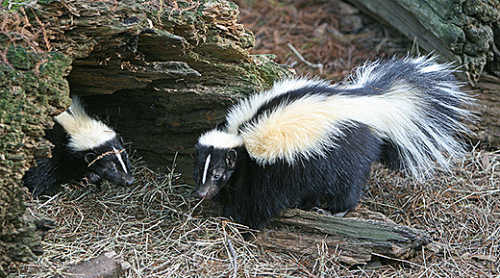
LAKE COUNTY, Calif. – Classified as mammals, striped skunks may look cuddly, but looks, as they say, may be deceiving.
These furry fellows are reportedly simple to domesticate and have been turned into pets by some. In the United States one would need to obtain a permit to do so.
There are skunks of many descriptions with varying fur colors and patterns, such as spotted, hooded, beige, black and white.
Here in Lake County we find striped skunks. Their distinctive color patterns are considered as warning colors.
The skunk's ubiquitous stripes are in place at birth, and some kits even sport stripes on their legs.
Here's a fancy word for you: crepuscular. Skunks are crepuscular creatures, meaning that they are most active just prior to dawn, and after dusk.
The skunk's usual preference is as a solitary creature, with the exception of those living in the colder regions. Then, they prefer to den together.
Their lengthy claws come in “handy” for digging up insect larvae, salamanders, snakes and lizards. They also dine on honey bees, teaching their young the nuances of hunting the winged insects.
Omnivores, skunks subsist on fungi, nuts, grasses and berries as well. The size of a striped skunk ranges in size from 15 to 37 inches and weighs in at 6 to 10 pounds. Their Arizona relatives, the hog-nosed skunk can weigh up 18 pounds.
The stinky portion of the skunk is located in its two anal scent glands which hold noxious-smelling chemicals comprised of sulphurs strong enough to keep bears at bay.
They have accurate “sites” on their “weapons” and spray targets accurately up to 10 feet, never squandering it, as their “magazine” holds only five or six doses before the requisite 10-day recoup time.
Contrary to popular belief, tomato juice is not the best way to neutralize odors if pets have been unlucky enough to be blasted with the skunk's weapon.
According to the Humane Society, use a concoction consisting of baking soda, liquid dishwashing soap and hydrogen peroxide instead.
Kathleen Scavone, M.A., is an educator, potter, writer and author of “Anderson Marsh State Historic Park: A Walking History, Prehistory, Flora, and Fauna Tour of a California State Park” and “Native Americans of Lake County.” She also writes for NASA and JPL as one of their “Solar System Ambassadors.” She was selected “Lake County Teacher of the Year, 1998-99” by the Lake County Office of Education, and chosen as one of 10 state finalists the same year by the California Department of Education.


 How to resolve AdBlock issue?
How to resolve AdBlock issue? 



